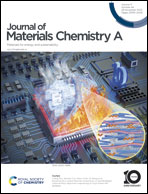Covalent modification of surfaces with porous metal–organic materials†
Abstract
Recent advances in metal–organic frameworks (MOFs) and porous coordination cages (PCCs) have led to their extensive use in various applications due to their tunable properties and exceptional surface areas. To address challenges in harnessing their tunability, surface deposition of MOFs and cages has been investigated. This paper presents efforts in surface attachment of MOFs and porous cages, leveraging click chemistry, alkylation reactions, and electrostatic approaches. HKUST-1 MOF nanoparticles were covalently tethered to an azide-modified gold surface using copper-catalyzed click chemistry, allowing precise control over the deposited layer. Calixarene and zirconium cages were also attached via click chemistry, providing controlled crystallinity and thickness. Complementary strategies using minimally-functionalized ligands enabled cage attachment to surfaces. These surface-attached porous materials offer versatile approaches for functionalizing surfaces in catalysis, sensing, drug delivery, and other applications, expanding the utility of porous materials in diverse fields. The results demonstrate the feasibility of surface attachment for porous cages.

- This article is part of the themed collection: Journal of Materials Chemistry A Emerging Investigators


 Please wait while we load your content...
Please wait while we load your content...